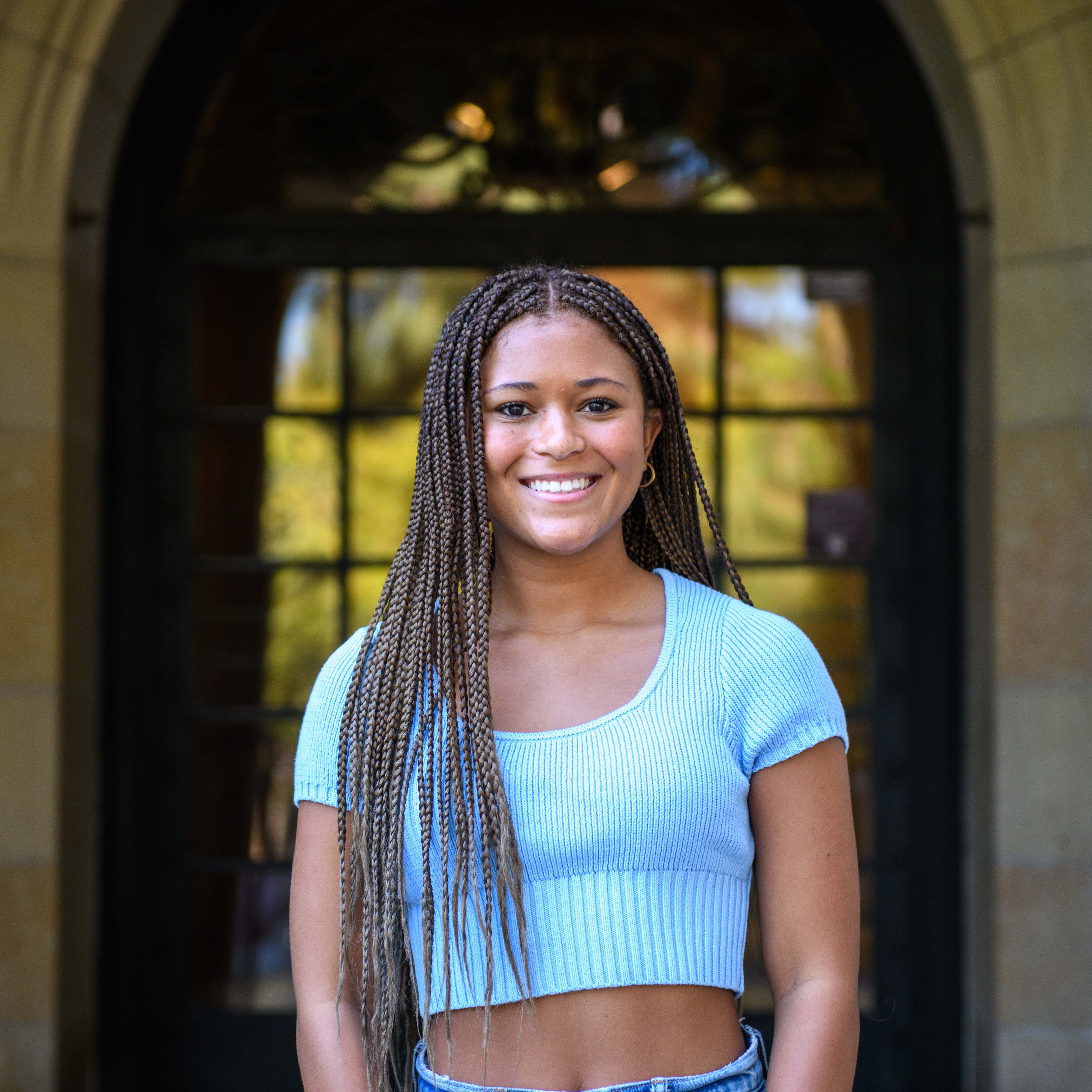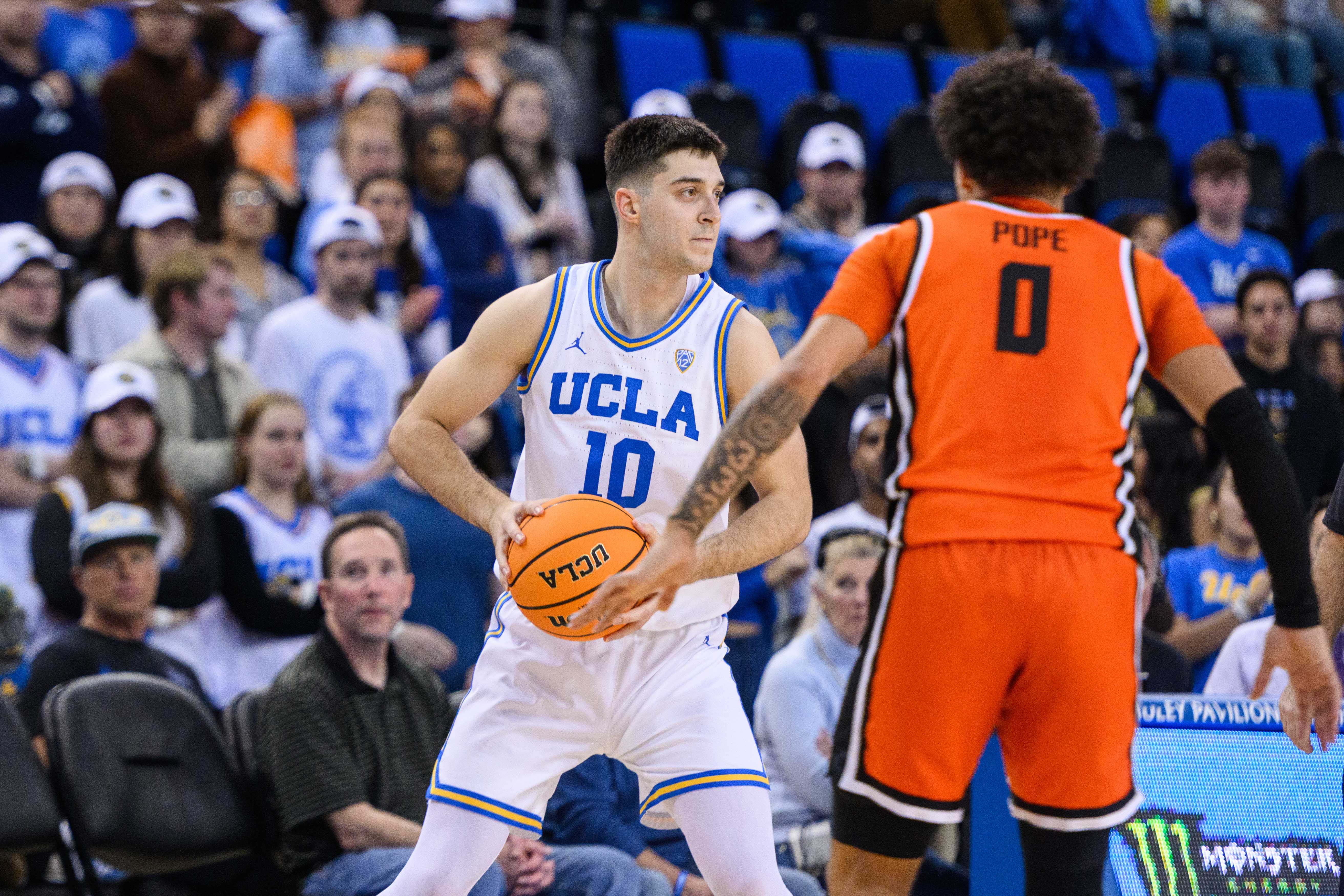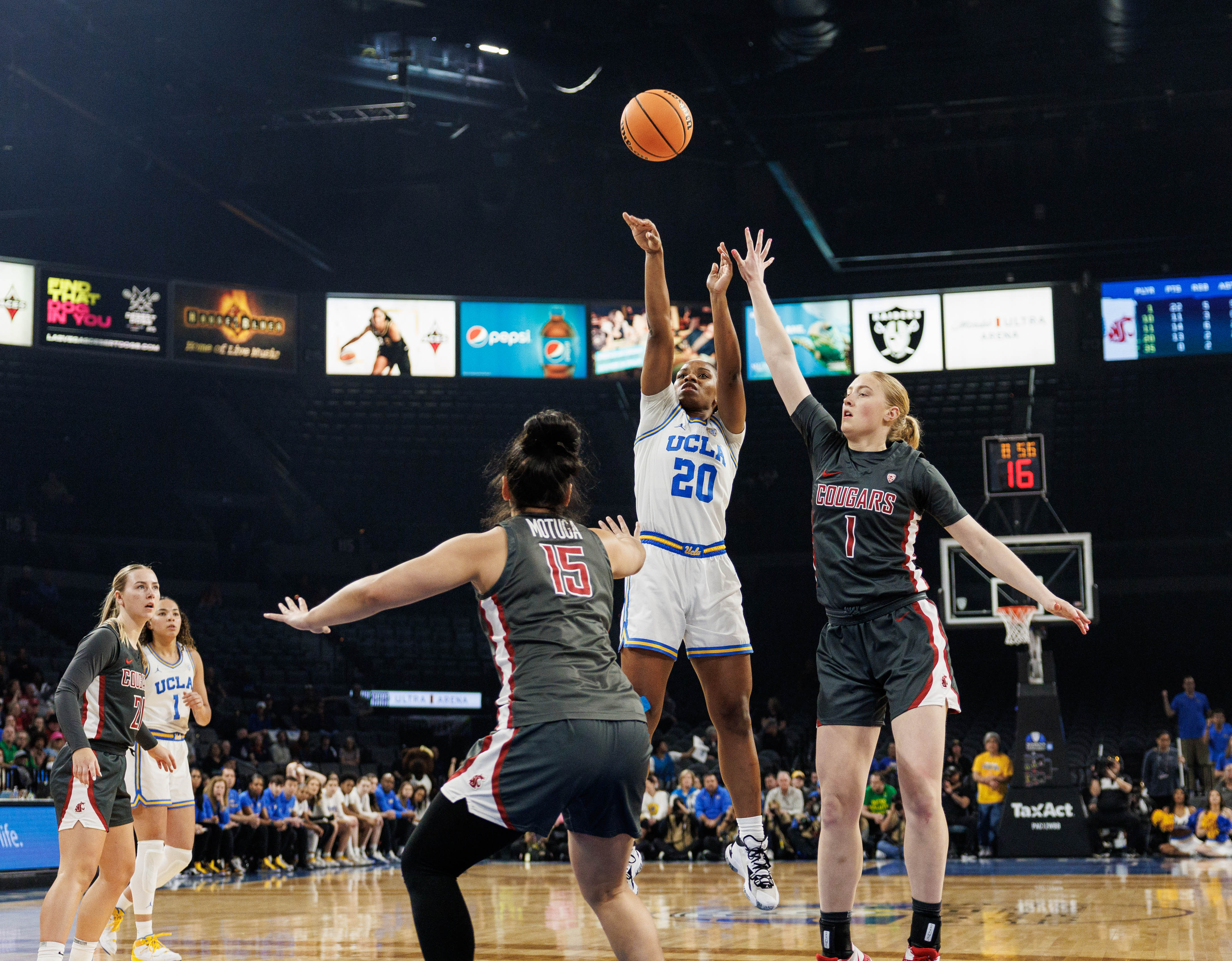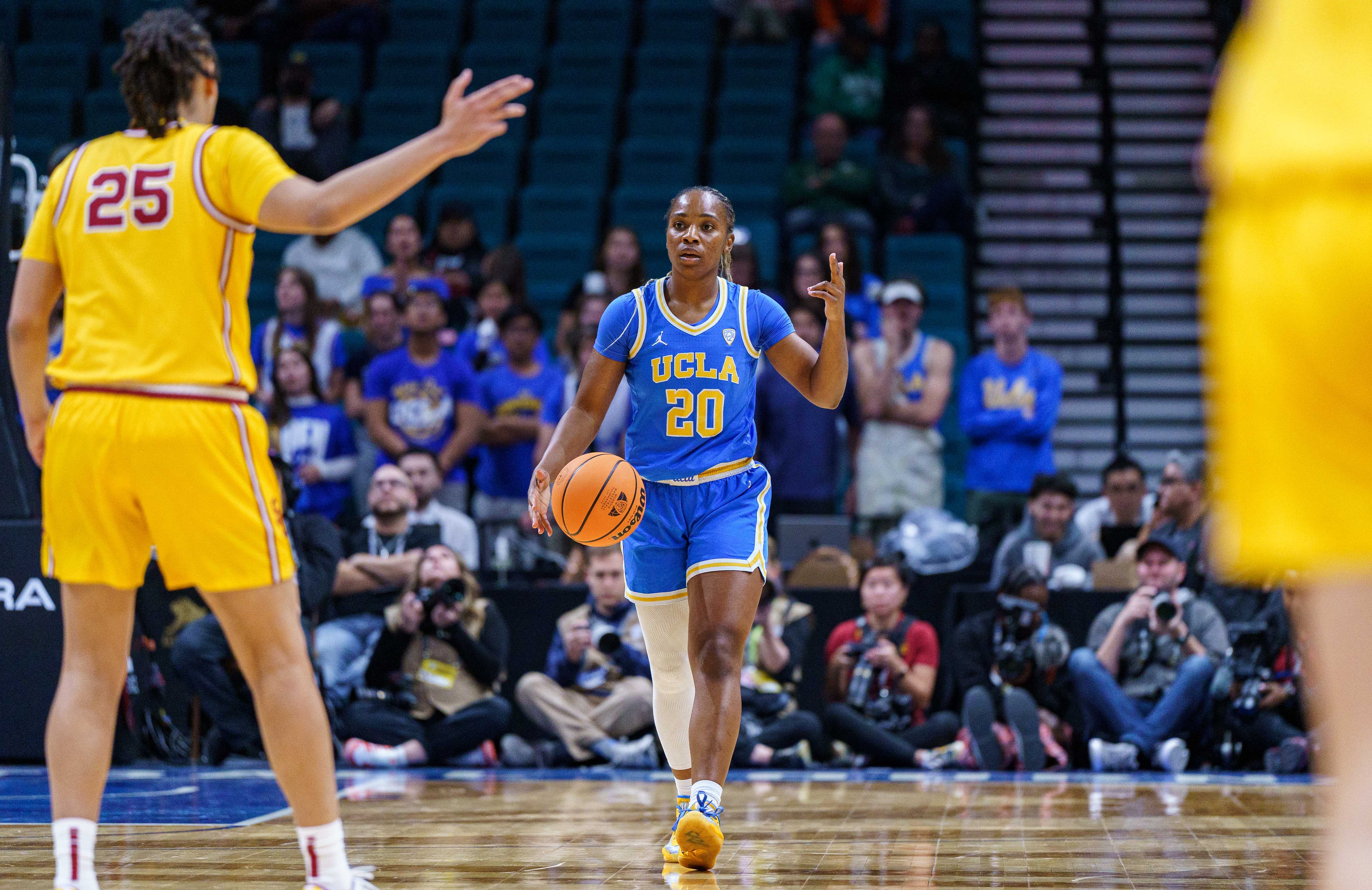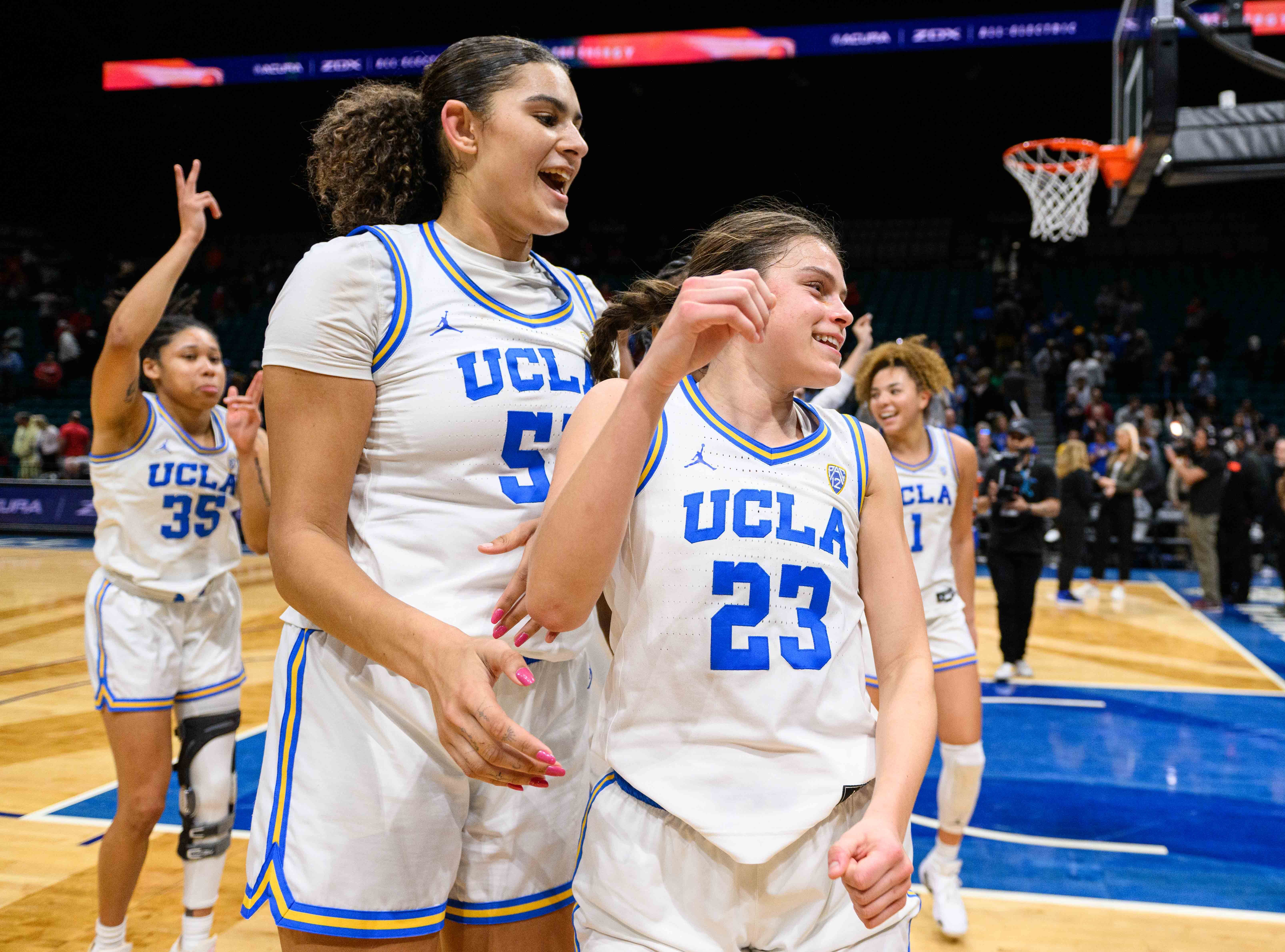Bull and Bear March: The opposite seasons of UCLA men’s, women’s basketball
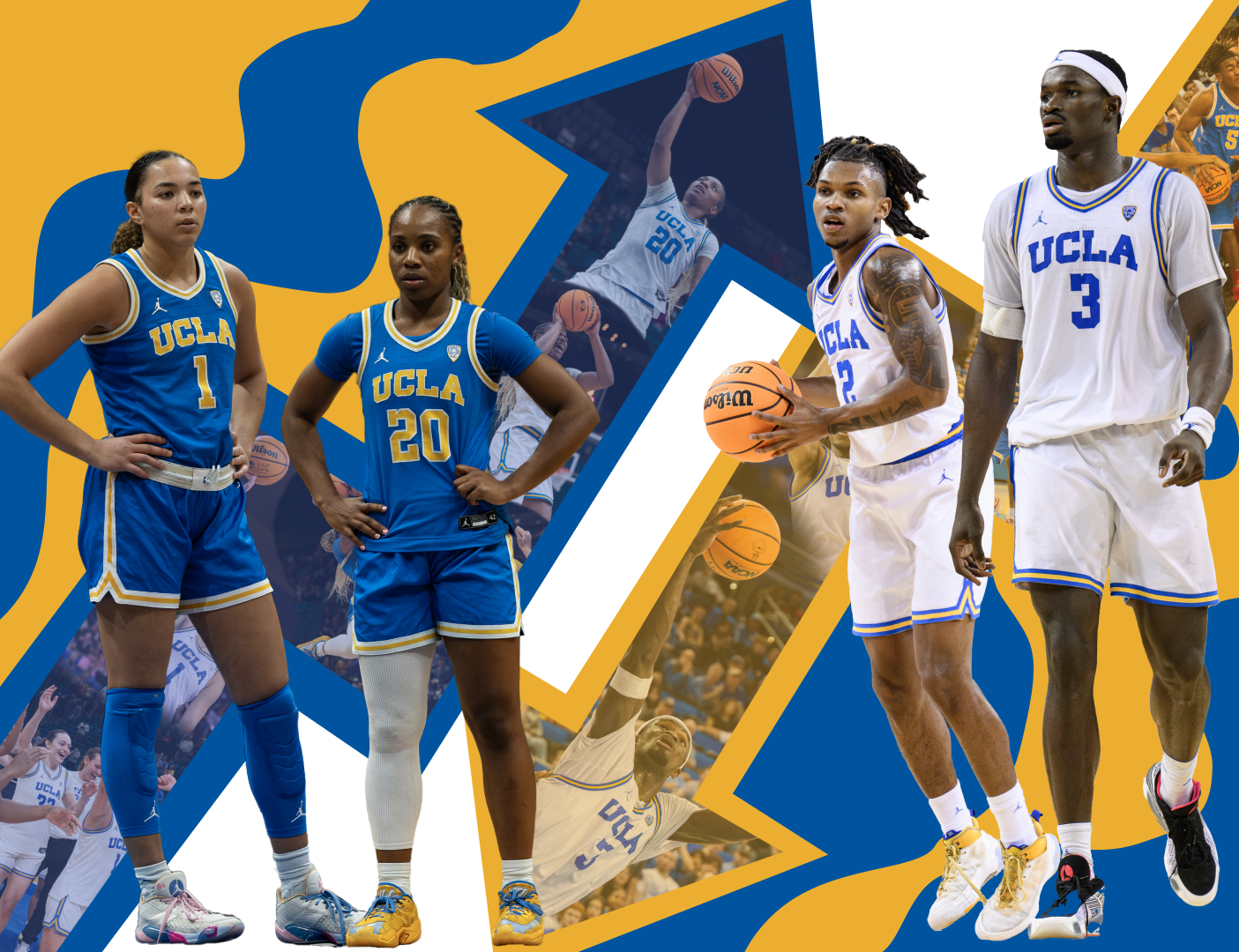
From left to right: UCLA women’s basketball sophomore guard Kiki Rice and graduate student guard Charisma Osborne and UCLA men’s basketball sophomore guard Dylan Andrews and sophomore forward/center Adem Bona are pictured. (Photos by Jeremy Chen/Photo editor, Myka Fromm/Photo editor and Brandon Morquecho/Photo editor. Photo illustration by Mia Tavares/Assistant Design director)
No. 2 seed UCLA women’s basketball is just days away from its Round of 64 contest against No. 15 seed California Baptist to start March Madness. And when it takes the floor, UCLA men’s basketball’s season will have been over for a week, ended by Oregon in the Pac-12 tournament quarterfinals. Both Bruin squads have been on opposite trajectories for much of the season, and that’s no different with the NCAA Tournament right around the corner. Assistant Sports editor Alexis Hinkle breaks down how the women’s team has been trending up for years as it competes for a national title, while Sports editor Joseph Crosby reviews the men’s team’s year and how its final descent spiraled into a second-round conference tournament exit.
Bull March
Alexis Hinkle, assistant Sports editor
The bull market occurs when stock prices are stable and on the rise.
It typically lasts for over six years, spurring economic growth and resisting competition.
Although the general trend is upward, the market ebbs and flows.
UCLA women’s basketball parallels the bull market, and its upcoming March Madness run is the result of an ascending climb and a continuous yearn to grow since its loss to Connecticut in the Sweet 16 back in 2019.
“I had told them that, if they would stay focused on the process and keep a growth mindset and get better and give to each other every day, that they could end up playing at this level,” said coach Cori Close after the Bruins’ defeat five years ago. “If you’re a great teammate, and you grow every day, something special can happen.”
And the Bruins have done just that.
They’ve stayed committed to the upward swing long enough to earn their highest ranking in program history and garner some of the best players in the nation. The team has now earned the No. 2 seed in the 2024 NCAA Tournament – its highest seed ever.
The following season after the Sweet 16 berth in 2019, UCLA went 26-5, winning 16 consecutive games and losing just one at home. Despite the pandemic-induced cancellation of the Big Dance that year, the Bruins continued to show growth as they picked up a bull and fighter in Charisma Osborne.
The then-freshman guard started in all but two games, led the team in made 3-pointers and tallied double-digit points 18 times. Osborne’s arrival in Westwood propelled UCLA to its fewest number of losses in a season in nine years.
Then the Bruins hit a wall the following year. And it wasn’t even of their own accord.
Canceled games, empty stands and injuries magnified by the COVID-19 pandemic hurt the Bruins in improbable ways. At one point, UCLA only had eight active players to cycle through its playing time.
A rock-bottom season was exactly what the program needed to continue its ascendance.
The struggles in 2020 showed the Bruins that they were capable of perseverance no matter the circumstances. Not only is it their hard work and talent, but it’s also the mindset enforced by Close’s coaching style.
When she talked about her team’s “growth mindset” in 2019, she prepared her team for the unprecedented ups and downs that would hamper the linear climb.
There was no Tournament in 2020, but the Bruins bounced back with an appearance in the first round in 2021, followed by a loss to Texas in the second.
But it wasn’t truly a setback. Rather, it was just what the Bruins needed to continue to move forward and ultimately become the strong team that they are today.
Close continued to build on the sentiment of the team after the struggles in 2020. Her team didn’t just have a growth mindset, but it had a winning one, too.
She brought in the No. 1 recruiting class in the nation for the 2022-2023 campaign and competed against the top teams in the country. In just its eighth game that season, UCLA faced then-No. 1 South Carolina on the road.
Although the Bruins lost to the Gamecocks by nine points, they showed that they could compete with the best teams in the nation and can sit at the dais with comfort.
Along with Osborne’s prowess, guards Kiki Rice and Londynn Jones stepped up to the plate in their freshmen seasons in the back court. Rice and Jones had the second- and fourth-most points on the team, respectively, and earned multiple conference honors.
Forwards Gabriela Jaquez, Christeen Iwuala and Lina Sontag have helped control the front court, grabbing rebounds and controlling the paint on both ends.
Behind the efforts of the then-freshmen and the experience of Osborne, the Bruins made yet another March Madness appearance but fell to then-No. 1 seed South Carolina in the Sweet 16.
But with the return of the five sophomores, alongside the addition of sophomore center Lauren Betts and the fifth season of graduate student guard Osborne, the Bruins have yet another opportunity at a longer March Madness run.
Close has said it repeatedly this season, but this is the Bruins’ deepest squad in years. The mindset is there, and it always has been. But now, veteran experience and talent are spread on the court and the bench. All the seats are filled.
And after holding its highest ranking in program history and defeating the most ranked teams in the country, the Bruins are primed for their most successful Tournament run.
It’s taken a lot to get here, as instability and fluctuation made the Bruins work for the reputation of their name.
But challenges are what made them stronger, and they are prepared for a chance at a national championship title.
Bear March
Joseph Crosby, Sports editor
UCLA’s mascots – Joe and Josie Bruin – are often figures of hope and optimism for fans. The bear pair work in tandem with the Spirit Squad to rally fans whether teams lead or trail.
Yet this March, the symbolism of the bear is taking on a different meaning.
The Bruins were on a downward slide as February bled into March, and even two late-season wins couldn’t save a shattered year. By the time the Pac-12 tournament rolled around, the daunting task of four wins in four days was all that could hand the team a shot at the NCAA Tournament.
But they wouldn’t be the ones to pull off that feat.
Oregon won all three of its games at the conference tournament in Las Vegas to steal a bid to the Big Dance, knocking off UCLA in the process. The Ducks pulled away in the second half and ended up narrowly hanging on – avoiding overtime after a miss by sophomore guard Dylan Andrews – before upsetting Arizona and Colorado en route to hoisting the final Pac-12 trophy.
The Bruins were relegated to a quarterfinals exit – their worst tournament showing since 2021 – with Andrews’ late game-saving shot attempt representing yet another miss for the season.
The story of UCLA’s season started in November. Months later, now is the time to take a look back at how the Bruins ended up in a Bear March instead of a mad one.
November and December
Three comfortable – and expected – wins set the table for UCLA in November and had the Bruins rolling before a trip to the Maui Invitational. A team chock full of inexperience desperately needed to get some under their belt, and the early season tournament provided just that.
UCLA had about as good a showing as could be expected in Hawaii, falling to now-No. 2 seed Marquette by two points and now-No. 5 seed Gonzaga by four. The Bruins showed flashes of promise, and, despite leaving the Aloha State with a pair of losses, things were looking up.
Until they weren’t.
Immediately following the Gonzaga loss, UCLA needed some late heroics from Andrews to stave off an upset loss by UC Riverside at Pauley Pavilion. The nation’s longest home winning streak was nearly snapped by a mid-major team.
That very streak came to an end a few weeks later.
Following back-to-back losses to Villanova on the road and Ohio State at the CBS Sports Classic, UCLA’s home advantage petered out against Cal State Northridge. A narrow Matador win moved the Bruins to 5-5 on the season with one nonconference game remaining – another eventual loss to Maryland.
In that two-month, 11-game span, UCLA’s defense still thrived. But a .294 3-point percentage – which would rank in the bottom-20 nationally if it still held today – spelled massive offensive hurdles for the Bruins.
With no quality wins and a losing record, UCLA needed to turn things around quickly during conference play to wash away early struggles and preserve a shot at an NCAA Tournament berth.
December to February
Things got worse for the Bruins before they got better, with a four-game losing streak that culminated in the second-largest loss in team history.
The only win in their first five games of conference play was a road victory over Oregon State, who ultimately finished last in the conference. All in all, UCLA hadn’t inspired the confidence that it could turn its season around.
Back-to-back wins against Washington and Arizona State were encouraging, but UCLA followed that up with a blown 19-point lead against now-No. 2 seed Arizona. Even when things were going well, they didn’t last, and the Bruins struggled to close out games.
But the next six contests suddenly resembled the first half of that matchup with the Wildcats.
UCLA picked up wins in its next six games – including the first road win against USC in coach Mick Cronin’s tenure and home victories over now-No. 10 seed Colorado and now-No. 11 seed Oregon – to bring them to 14-11 on the year.
The Bruins had somehow picked up wind. Winning out would give them a strong chance for an at-large March Madness bid despite a rocky nonconference slate and would practically guarantee a first-round bye in the Pac-12 tournament. The first real bright spot of the year had shone light on a path to the postseason.
Until the Bear of March snuffed it out.
February and March
Where winning out was necessary, UCLA nearly lost out instead.
Another losing streak – this one five games long – had the Bruins on the precipice of the ninth seed in the Pac-12 tournament with one game to go. A losing regular season had already been guaranteed after a blow out by the Wildcats at home, and UCLA needed a win over Arizona State just to break even in conference play.
They got it, no thanks to a dismal 47-point performance from a Sun Devil team that lost its second-leading scorer – who left the team to pursue professional opportunities – shortly before the game. The win handed the Bruins the No. 5 seed in the Pac-12 tournament that was practically a sympathy gift more than anything else.
Streaky play defined UCLA’s Pac-12 slate, but the outcome was the same. The Bruins had a middling season, and they finished with 10 wins and 10 losses against conference opponents regardless of how they got there.
That win-one, lose-one type play continued to the Pac-12 tournament, where UCLA defeated Oregon State before falling to Oregon.
Expectations for this season were never a national championship. The Bruins were simply too young with not enough returning experience for a deep NCAA Tournament run. But what resulted of the year was still a disappointment with the team’s fifth losing season this century.
There was minimal success this year. Now, UCLA can only hope its next March is as bullish as the women’s team’s is.




